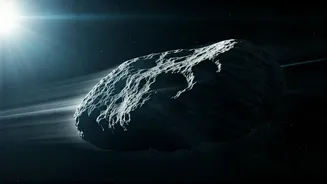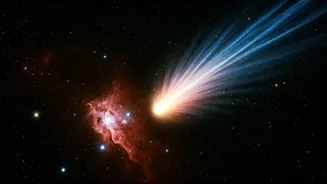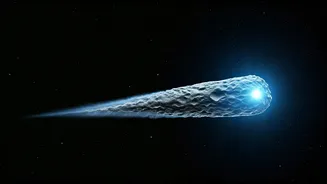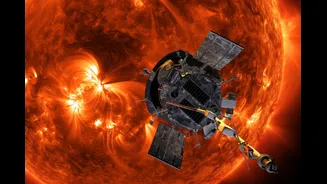Unveiling the Anomaly
The 3I/ATLAS comet has recently been the focus of intense observation, with new images presenting unexpected behavior. Unlike the predictable trajectories
of most comets, 3I/ATLAS exhibits 'anti-trails.' These trails seem to move away from the sun, a phenomenon that has left astronomers intrigued. Conventional models of cometary activity struggle to fully account for this behavior. Typically, comet tails are formed from ice and dust vaporizing due to solar radiation, trailing behind the comet as it moves away from the sun. The presence of anti-trails challenges this understanding, suggesting alternative processes at play, or potentially, a unique composition of this specific comet. The images have triggered a wave of speculation among space enthusiasts and experts alike.
Decoding the Trails
The peculiar behavior of the 3I/ATLAS comet necessitates a closer look at the potential causes of its unusual trails. One likely theory relates to the comet's composition. It's plausible that the comet's nucleus contains a high percentage of volatile materials. When exposed to solar radiation, these materials might sublimate, creating a tail that interacts with solar winds in a manner that produces the anti-trail effect. Another possibility is the presence of jet thrusters, areas on the comet where volatile materials are ejected, propelling the comet in an unexpected direction, which could explain the trails. This would be a significant departure from standard comet activity. However, no definitive answer is immediately available, so further study and data collection is needed. This comet gives us a new chance to expand our grasp on cometary dynamics.
Looking Ahead: Research
The scientific community's interest in 3I/ATLAS is significant, with future study and observation planned. Experts are analyzing these new images, and are using advanced modeling to simulate the comet's behavior. They are also seeking more data, including spectroscopy information, to determine the comet's chemical makeup. This information could reveal the materials present and offer valuable insights into the formation process of the trails. These actions are crucial in order to either validate or reject existing theories, which will enable scientists to develop a more precise understanding of how comets interact with the sun and interstellar space. The findings could also shed light on the origin and history of our solar system, making this research effort particularly relevant.
Impact on Astronomy
The study of the 3I/ATLAS comet will likely have a long-lasting impact on astronomy and planetary science. The observation of anti-trails, rather than conventional tails, challenges previous understanding and necessitates adjustments to prevailing models of cometary activity. As the comet becomes a major study subject, scientists may discover similar examples, altering our overall grasp of comets. Moreover, the techniques and knowledge gained from studying 3I/ATLAS could inform research on other celestial bodies, like asteroids and other space debris, further expanding our knowledge of the universe. This phenomenon provides a valuable case study to help improve our current scientific understanding.
















